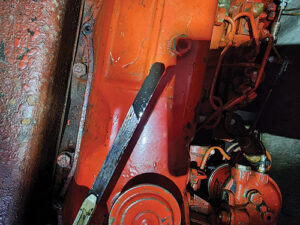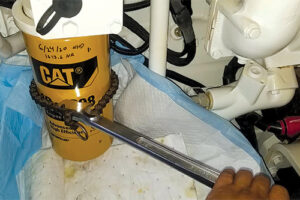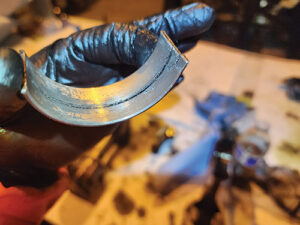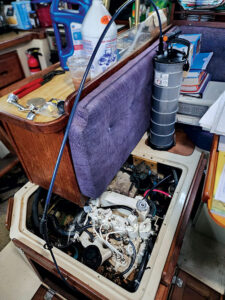Winter is upon us and many boaters are preparing their engines for winter storage, when they may sit or only be run periodically over the next few months. During the winterization process, one of the more important maintenance items is to change the oil prior to storage, just as changing the oil prior to the boating season is also a good idea. While changing your oil isn’t terribly complicated, it can be intimidating for those who have not tackled the project before or those who have but ran into some unforeseen trouble. I hope the following tips and tricks will aid you in the process and reveal some reasons that oil changes are so beneficial to your engine in the long run. Take your time and don’t skimp on the products or the procedure—it is worth the money and effort to do it right.
RUN YOUR ENGINE FIRST

Before starting the oil change, run your engine first and warm it up. This will suspend any debris that is not captured by the filter and help the oil drain quickly and easily. Warm oil is less viscous and will flow much easier; and during a recent circulation of oil, any condensation or crud that may have formed on metallic surfaces will be picked up during operation and come out with the oil. The more contaminants you can get out, the better.
NEXT STEPS: USE A HIGH QUALITY OIL FILTER AND DON’T OVERTIGHTEN IT.
After warming up your oil, the first step of an oil change is to drain the engine of its old oil. Most of the time with boat engines, that means using either a pump or vacuum extractor. This is followed by replacing your oil filter.

When you go to install a new filter, make sure to use high quality components to prevent further issues over the long term. I have seen many engines with the wrong oil filter installed, like a fuel filter that happens to fit in the oil filter’s place, or just the world’s cheapest, crappiest oil filter. Cheap filters from brands like Fram or Carquest are not built with much of a quality standard, so avoid these as they tend to disintegrate over a short period of time. Check your manual for the recommended filter and, if possible, buy one that meets or exceeds the manufacturer’s specs. For example, Cummins engines call for Fleetgaurd brand filters since they meet Cummins’ minimum filter specs and are great filters, but if you want an even higher quality filter, a Caterpiller filter would exceed their specs for an oil filter. You can actually void the warranty if you were to run something like a Fram on a modern Cummins or CAT diesel engine.
For those of us sailors with smaller engines and compartments, we most likely won’t be able to find a small enough CAT filter to fit our Kubota or Yanmar engines. In this case, finding a manufacturer-branded filter (like BETA, Yanmar, or Universal) or a Kubota brand filter will do the job more than well enough as those filters are built to meet or exceed their engine’s requirements for filtration.
For those of you with super strong hands, please don’t crank that filter on tight. Lube your filter O-ring with oil or a lubricant like Sil-Glyde and you will have a much easier time getting it off. I can’t tell you how many filters I have destroyed trying to get them off. Not fun.
THE TYPE AND QUALITY OF YOUR OIL MATTERS TOO

Choosing the correct engine oil for your diesel engine is as simple as checking your manual and checking in with a professional if your engine has special circumstances like excessive wear or burning oil. Most mechanical diesel engines call for 15w-40 or 10w-30 “mineral” oils, meaning they are not synthetic. Since a majority of the mechanical engines I work on are flat tappet engines, I recommend a brand like Chevron, which has a higher zinc content in it that is good for keeping flat tappet engines happy. Make sure to not mix different weights of oils and also don’t mix synthetic with mineral oils. If the engine calls for a synthetic oil or a certain weight of oil, stick to that unless you are burning oil or the engine is very worn. In that case it’s best to consult a mechanic who can recommend a change in oil that may help.
Synthetic oil contains more detergents and can harm old engines by potentially loosening up carbon deposits that have been there for a while. On more modern diesels, sometimes lighter-weight synthetic oils can be used, as the engine may have hydraulic components that are run with engine oil. An example of this may be hydraulic lifters or variable valve timing—commonly seen on automotive engines, but also out there on certain marinized diesel applications. If you are in a climate where the temperatures drop or rise dramatically, then refer to your manual about when to run higher/lower weight oils for differing outside temps. Here in the Pacific Northwest, we are lucky because we don’t typically experience dramatic temperature fluctuations, so we can get away with running one type and weight of oil year-round.
DON’T OVERFILL YOUR ENGINE

This may seem obvious, but there is such a thing as too much good stuff. When you refill your engine with fresh oil, fill to the top line on the dipstick and then run the engine for a few seconds to build oil pressure before checking the dipstick again to top off. This allows the oil galleries to fill and the empty filter to fill. Don’t overfill the engine though, too much oil in the oil pan can come into contact with the rotating assembly of the crankshaft and become agitated and foamy—things that we don’t want. Most oils have an anti-foam agent in their ingredient list, however this can only do so much. Foamy oil will not be able to create a solid oil film in between bearing surfaces and other metal contact surfaces, thus you will have metal-on-metal damage and that is just as harmful as running the engine when it is low on oil. It’s easy to avoid damage like this. If you overfilled a bit, no worries, just extract/drain it out.
KEEP A RECORD
Once you’ve refilled your engine with fresh oil and have installed your new filter, you are done with your oil change. Make sure to log this in your records, or at least include a sticker on the engine or filter so you know the hours and date of when you did it last. This will be helpful to you, your mechanic, and/or your boat’s future owner.
Changing the oil is probably one of the most basic, yet important, items on our maintenance to-do lists. Oil not only lubricates our metallic sliding/rotating assembly, but it also helps to clean and keep things cool as well. Changing your oil before winter storage is helpful as it can remove contaminants from the boating season like acids and other crud that forms over time. If you want to “flush” your engine, never use an engine flush or cleaners inside the engine. Changing your oil several times in rapid succession can really help clean out your engine just like in the break-in period for a new engine. Take your time, use good quality materials, and your engine will thank you.
Meredith Anderson is the owner of Meredith’s Marine Services, where she operates a mobile mechanic service and teaches hands-on marine diesel classes to groups and in private classes aboard clients’ own vessels.






